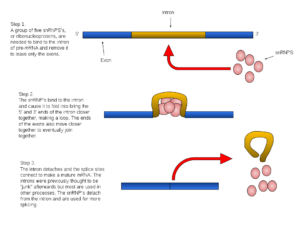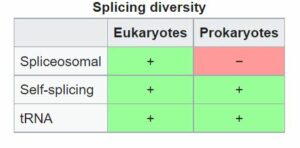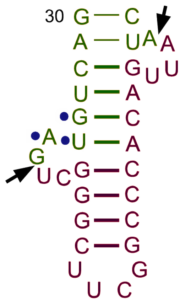Splicing is the process of removing introns in mRNA.
To the question “Does splicing occur in Prokaryotes?” the answer is vague as it cannot be answered in a definite manner. Spicing occurs only in non-coding RNA in prokaryotes, the process is something similar to splicing.
According to biological terms, splicing refers to the removal of introns from hnRNA and joining the exons to make the pure mRNA strand.
Does splicing occur in all cells?
Splicing is a process of removal of unnecessary parts of RNA and occurs in all organisms.
The most accustomed mRNA splicing is unique to eukaryotes, while in prokaryotes splicing though rare is found to occur in non-coding RNA i.e usually in tRNA.
In prokaryotes, the genetic material is small in quantity and comprises entirely of coding genes. To remove parts of this transcripted RNA in the name of processing is not only unnecessary but would be considered a wastage of resources in the cell.

Image: Wikipedia
Does mRNA splicing occur in prokaryotes?
Splicing of mRNA is a form of post-transcriptional modification.
mRNA splicing is not a phenomenon that occurs in prokaryotes, it is exclusive to eukaryotes. Prokaryotic splicing is found to occur only in non-coding RNA types.
Since prokaryotes have a small gene count, on transcription a pure mRNA strand is produced that does not require any further processing. Unlike eukaryotes that produce heteronuclear RNA on transcription that must be converted to mRNA to be further translated to protein.
Does gene-splicing occur in prokaryotes?
Gene splicing does not occur in prokaryotes as it is simply not required.
Because of its tiny size, bacterial DNA contains coding genes across its whole length. Unlike eukaryotes, which contain extensive chromosomal DNA and non-coding gene segments.

Image Wikipedia
These non-coding regions of the genes are eliminated when they are turned to RNA, leaving just the coding components of the genes. The result of transcription in prokaryotes is mRNA as compared to hnRNA that is further converted to mRNA in eukaryotes after splicing.
Does RNA splicing occur in prokaryotic cells?
Though rare, RNA splicing does occur in prokaryotes.
Unlike in eukaryotes splicing in prokaryotes occurs in non-coding RNA varieties like in tRNA. Even then the occurrence of splicing is quite a rare phenomenon in prokaryotic cells.

Image: Wikipedia
tRNA in prokaryotes is processed via splicing mainly to convert it into its active formylated form. Only in this form can tRNA function and assist in translation from mRNA to protein.
Does post-transcriptional splicing occur in prokaryotes?
Post-transcriptional processing is a feature unique to eukaryotic cells.
Prokaryotic transcription produces a pure mRNA strand that does not require any changes and can be used as it is to translate it to protein. It is specifically hnRNA that is required to undergo splicing to be converted to mRNA.

Image: Wikipedia
The entire length of the prokaryotic DNA has coding genes, due to its small size. Unlike eukaryotes that have large chromosomal DNA and parts of the gene are non-coding. On being converted to RNA these non-coding parts are removed to keep only the coding portions of the genes.
Is there alternative splicing in prokaryotes?
Alternative splicing if referred to that of non-coding mRNA does occur in prokaryotes.
In prokaryotes, splicing can be seen in tRNA or transfer RNS to produce it functional form with the attachment of a formalin derivative. This processing of the tRNA allows it to attach to the mRNA and translate the mRNA to its respective protein molecule.
Does splicing occur in the cytoplasm?
Splicing of hnRNA is a nuclear phenomenon.
Splicing does not occur in the eukaryotic cytoplasm but rather in the nucleus. Another reason it is seen in eukaryotes as prokaryotes do not have a nucleus.
Splicing is a post transcription process i.e it occurs after transcription that itself occurs in the nucleus. The hnRNA produced in transcription is converted to mRNA via splicing in the nucleus itself before moving to the cytoplasmic Golgi bodies for the next part i.e translation.
Where does splicing occur?
Eukaryotic spicing occurs in the nucleus while prokaryotic splicing in the cytoplasm.
In eukaryotes, splicing occurs right after transcription which itself occurs in the nucleus so, the post-transcriptional processing occurs in the nucleus as well after which the mRNA moves into the cytoplasm.
On the other hand, prokaryotic splicing occurs in tRNA and other non-coding RNAs which are found in the cytoplasm, hence the process of splicing occurs in the cytoplasm as well. Also since prokaryotic cells do not have a nucleus, splicing cannot technically occur in the nucleus in prokaryotic cells anyway.
Please click to learn more about Do Prokaryotes Have Golgi.
Also Read:
- Biennial plant example
- Can rna leave the nucleus
- Do prokaryotes have enzymes
- Fibrous protein example
- Are diatoms protists
- Is cell membrane an organelle
- Are cell wall an organelle
- Do plant cells have endoplasmic reticulum
- Turbellaria characteristics
- Is endocytosis hypertonic

I am Trisha Dey, a postgraduate in Bioinformatics. I pursued my graduate degree in Biochemistry. I love reading .I also have a passion for learning new languages.
Let’s connect through linked in: